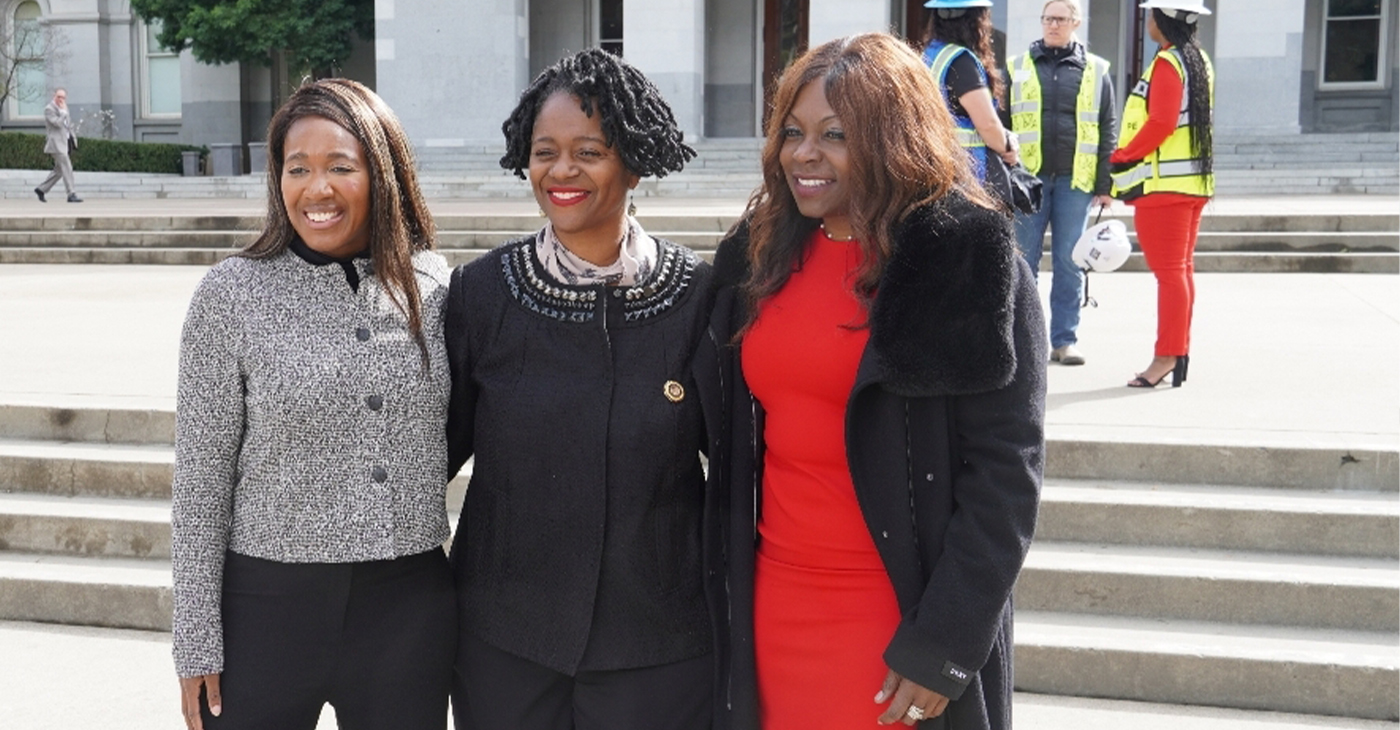National
Report: Black Girls Should Matter, Too
George E. Curry
NNPA Columnist
WASHINGTON (NNPA) –Black girls are disproportionately suffering from punitive school disciplinary policies and actions yet society fails to take note of their plight the way attention is focused on Black males who get trapped in the school-to-prison pipeline, according to a report by the African American Policy Forum, a New York-based national think tank connecting academics, activists, and policy-makers whose goal is to dismantle structural inequality.
The report, titled “Black Girls Matter: Pushed-Out, Overpoliced and Underprotected,” was scheduled to be released on Wednesday, Feb. 4. A copy of the report was obtained in advance by the National Newspaper Publishers Association (NNPA) News Service.
Anyone who doubts that Black girls are being severely disciplined for minor infractions in school need to look no further than reporting in their local media to learn otherwise, according to the report.
The report noted:
“In 2007, a 6-year-old girl was arrested in a Florida classroom for having a tantrum. Later that year, a 16-year-old girl was arrested in a California school for dropping cake on the floor and failing to pick it up to a school officer’s satisfaction.
“In 2013, an 8-year-old girl in Illinois was arrested for acting out, and a16-year-old girl in Alabama who suffers from diabetes, asthma, and sleep apnea was hit with a book by her teacher after she fell asleep reading The Adventures of Huckleberry Finn in class. The student was later arrested and hospitalized due to injuries caused by violent interactions with the police. Also in 2013, in Florida, a 16-year-old was arrested when her ‘science experiment’ caused a small explosion in her classroom and a 12-year-old girl was threatened with expulsion from an Orlando private school unless she changed the look of her natural hair.
“In 2014, a 12-year-old girl faced expulsion and criminal charges after writing ‘hi’ on a locker room wall of her Georgia middle school, and a Detroit honors student was suspended for the entire senior year for accidently bringing a pocketknife to a football game.”
The U.S. Department of Education reported last March that for the 2011-2012 school year:
“Black students are suspended and expelled at a rate three times greater than white students. On average, 5% of white students are suspended, compared to 16 % of black students.
“While boys receive more than two out of three suspensions, black girls are suspended at higher rates (12%) than girls of any other race or ethnicity and most boys.”
In addition, “Black students represent 16 % of student enrollment, 27 % of students referred to law enforcement, and 31% of students subjected to a school-related arrest. In comparison, white students represent 51% of students enrolled, 41% of referrals to law enforcement, and 39% of those subjected to school-related arrests.”
That disproportionate pattern begins at an early age.
Black children represent 18 percent of preschool enrollment but 48 percent of preschool children receiving more than one out of school suspension. On the other hand, White students represented 43 percent of preschool enrollment but only 26 percent of preschool children receiving more than one out of school suspension, according to the Department of Education.
The African American Policy Forum report grew out of a 2012 conference it convened on girls of color at the UCLA Law School.
“Girls have rarely been included in either the discussions about exclusionary disciplinary policies or the broader concerns about the underachievement of youth of color,” the report stated. “Yet the data suggest that Black girls face a variety of factors – historical, institutional, and social – that heighten their risk of underachievement and detachment from school, as well as the lifelong consequences of dropping out.”
It explained, “Research and public policy debates, however, often fail to paint a nuanced picture that addresses the degree to which girls are vulnerable to many of the same factors faced by their male counterparts. For example, reports about zero-tolerance and push-out policies frequently fail to disaggregate or highlight the consequences of such policies for girls of color. Available information about the challenges that they face in regards to suspension, expulsion, and other disciplinary practices often go underreported, leading to the incorrect inference that their futures are not also at risk.”
Among the report’s observations:
• At-risk young women say that in zero-tolerance schools, discipline receives a higher priority than educational attainment;
• Increased levels of law enforcement and security personnel sometimes make girls feel less safe and therefore less likely to attend school;
• Black girls sometimes get attention than males because they are perceived as more socially mature and self-reliant;
• Conflicts better addressed through counseling are too frequently referred to the juvenile justice system;
• Failure of schools to intervene in instances of physical or sexual harassment of girls contributes to their insecurity at school;
• Girls sometimes resort to “acting out” when their counseling needs are overlooked or disregarded;
• School-age Black girls experience a high incidence of personal violence;
• Girls are often burdened with family obligations that undermine their capacity to achieve their goals and
• Pregnancy and parenting make it difficult for girls to engage fully in school.
Recommendations included providing funding programs that serve the needs of women and girls as well as men and boys; reducing the overreliance on punitive interventions; create an environment where students are free of sexual harassment; devise programs that help identify and assist students who have been sexually victimized or traumatized by violence; offer support programs for pregnant girls or mothers with young children and mobilize the public to help address the challenges facing young girls.
Authors of the report funded by the Schott Foundation stated, “This modest but long-overdue effort to cast light onto the lives of marginalized girls should be replicated and expanded across the nation.
Ideally, the conversation ‘Black Girls Matter: Pushed Out, Overpoliced, and Underprotected’ engenders within communities and among philanthropists, policy makers, stakeholders, and advocates will lead to the inclusion of girls in efforts to address school discipline, pushout, and the pathways to incarceration, poverty, and low-wage work. We are hopeful that ongoing efforts to resolve the crisis facing boys of color will open up opportunities to examine the challenges facing their female counterparts.”
Activism
Oakland Post: Week of March 28 – April 1, 2025
The printed Weekly Edition of the Oakland Post: Week of March 28 – April 1, 2025

To enlarge your view of this issue, use the slider, magnifying glass icon or full page icon in the lower right corner of the browser window.
Activism
Sen. Lola Smallwood-Cuevas Honors California Women in Construction with State Proclamation, Policy Ideas
“Women play an important role in building our communities, yet they remain vastly underrepresented in the construction industry,” Smallwood-Cuevas stated. “This resolution not only recognizes their incredible contributions but also the need to break barriers — like gender discrimination.

By Antonio Ray Harvey, California Black Media
To honor Women in Construction Week, Sen. Lola Smallwood-Cuevas (D-Los Angeles), a member of the California Legislative Black Caucus (CLBC), introduced Senate Concurrent Resolution (SCR) 30 in the State Legislature on March 6. This resolution pays tribute to women and highlights their contributions to the building industry.
The measure designates March 2, 2025, to March 8, 2025, as Women in Construction Week in California. It passed 34-0 on the Senate floor.
“Women play an important role in building our communities, yet they remain vastly underrepresented in the construction industry,” Smallwood-Cuevas stated. “This resolution not only recognizes their incredible contributions but also the need to break barriers — like gender discrimination.
Authored by Assemblymember Liz Ortega (D-San Leandro), another bill, Assembly Concurrent Resolution (ACR) 28, also recognized women in the construction industry.
The resolution advanced out of the Assembly Committee on Rules with a 10-0 vote.
The weeklong event coincides with the National Association of Women In Construction (NAWIC) celebration that started in 1998 and has grown and expanded every year since.
The same week in front of the State Capitol, Smallwood, Lt. Gov. Eleni Kounalakis, Assemblymember Josh Hoover (R-Folsom), and Assemblymember Maggie Krell (D-Sacramento), attended a brunch organized by a local chapter of NAWIC.
Two of the guest speakers were Dr. Giovanna Brasfield, CEO of Los Angeles-based Brasfield and Associates, and Jennifer Todd, President and Founder of LMS General Contractors.
Todd is the youngest Black woman to receive a California’s Contractors State License Board (A) General Engineering license. An advocate for women of different backgrounds, Todd she said she has been a woman in construction for the last 16 years despite going through some trying times.
A graduate of Arizona State University’s’ Sandra Day O’Connor College of Law, in 2009 Todd created an apprenticeship training program, A Greener Tomorrow, designed toward the advancement of unemployed and underemployed people of color.
“I always say, ‘I love an industry that doesn’t love me back,’” Todd said. “Being young, female and minority, I am often in spaces where people don’t look like me, they don’t reflect my values, they don’t reflect my experiences, and I so persevere in spite of it all.”
According to the U.S. Bureau of Labor Statistics, only 11.2% of the construction workforce across the country are female. Overall, 87.3% of the female construction workers are White, 35.1% are Latinas, 2.1% are Asians, and 6.5% are Black women, the report reveals.
The National Association of Home Builders reported that as of 2022, the states with the largest number of women working in construction were Texas (137,000), California (135,000) and Florida (119,000). The three states alone represent 30% of all women employed in the industry.
Sen. Susan Rubio (D-Baldwin Park) and the California Legislative Women’s Caucus supported Smallwood-Cuevas’ SCR 30 and requested that more energy be poured into bringing awareness to the severe gender gap in the construction field.
“The construction trade are a proven path to a solid career. and we have an ongoing shortage, and this is a time for us to do better breaking down the barriers to help the people get into this sector,” Rubio said.
Activism
Report Offers Policies, Ideas to Improve the Workplace Experiences of Black Women in California
The “Invisible Labor, Visible Struggles: The Intersection of Race, Gender, and Workplace Equity for Black Women in California” report by the California Black Women’s Collective Empowerment Institute (CBWCEI), unveiled the findings of a December 2024 survey of 452 employed Black women across the Golden State. Three-fifths of the participants said they experienced racism or discrimination last year and 57% of the unfair treatment was related to incidents at work.

By McKenzie Jackson, California Black Media
Backed by data, a report released last month details the numerous hurdles Black women in the Golden State must overcome to effectively contribute and succeed in the workplace.
The “Invisible Labor, Visible Struggles: The Intersection of Race, Gender, and Workplace Equity for Black Women in California” report by the California Black Women’s Collective Empowerment Institute (CBWCEI), unveiled the findings of a December 2024 survey of 452 employed Black women across the Golden State. Three-fifths of the participants said they experienced racism or discrimination last year and 57% of the unfair treatment was related to incidents at work.
CBWCEI President and CEO Kellie Todd Griffin said Black women have been the backbone of communities, industries, and movements but are still overlooked, underpaid, and undervalued at work.
“The data is clear,” she explained. “Systemic racism and sexism are not just historical injustices. They are active forces shaping the workplace experiences of Black women today. This report is a call to action. it demands intentional polices, corporate accountability, and systemic changes.”
The 16-page study, conducted by the public opinion research and strategic consulting firm EVITARUS, showcases the lived workplace experiences of Black women, many who say they are stuck in the crosshairs of discrimination based on gender and race which hinders their work opportunities, advancements, and aspirations, according to the report’s authors, Todd Griffin and CBWCEI researcher Dr. Sharon Uche.
“We wanted to look at how Black women are experiencing the workplace where there are systematic barriers,” Todd Griffin told the media during a press conference co-hosted by Ethnic Media Services and California Black Media. “This report is focused on the invisible labor struggles of Black women throughout California.”
The aspects of the workplace most important to Black women, according to those surveyed, are salary or wage, benefits, and job security.
However, only 21% of the survey’s respondents felt they had strong chances for career advancement into the executive or senior leadership ranks in California’s job market; 49% felt passed over, excluded from, or marginalized at work; and 48% felt their accomplishments at work were undervalued. Thirty-eight percent said they had been thought of as the stereotypical “angry Black woman” at work, and 42% said workplace racism or discrimination effected their physical or mental health.
“These sentiments play a factor in contributing to a workplace that is unsafe and not equitable for Black women in California,” the report reads.
Most Black women said providing for their families and personal fulfillment motivated them to show up to work daily, while 38% said they were dissatisfied in their current job with salary, supervisors, and work environment being the top sources of their discontent.
When asked if they agree or disagree with a statement about their workplace 58% of Black women said they feel supported at work, while 52% said their contributions are acknowledged. Forty-nine percent said they felt empowered.
Uche said Black women are paid $54,000 annually on average — including Black single mothers, who averaged $50,000 — while White men earn an average of $90,000 each year.
“More than half of Black families in California are led by single Black women,” said Uche, who added that the pay gap between Black women and White men isn’t forecasted to close until 2121.
-

 #NNPA BlackPress4 weeks ago
#NNPA BlackPress4 weeks agoTarget Takes a Hit: $12.4 Billion Wiped Out as Boycotts Grow
-

 Activism3 weeks ago
Activism3 weeks agoUndocumented Workers Are Struggling to Feed Themselves. Slashed Budgets and New Immigration Policies Bring Fresh Challenges
-

 #NNPA BlackPress4 weeks ago
#NNPA BlackPress4 weeks agoBREAKING Groundbreaking Singer Angie Stone Dies in Car Accident at 63
-

 Activism4 weeks ago
Activism4 weeks agoOakland Post: Week of February 26 – March 4, 2025
-

 #NNPA BlackPress4 weeks ago
#NNPA BlackPress4 weeks agoNAACP Legend and Freedom Fighter Hazel Dukes Passes
-

 Arts and Culture4 weeks ago
Arts and Culture4 weeks agoBeverly Lorraine Greene: A Pioneering Architect and Symbol of Possibility and Progress
-

 #NNPA BlackPress4 weeks ago
#NNPA BlackPress4 weeks agoTrump Kicks the Ukrainian President Out of the White House
-

 #NNPA BlackPress4 weeks ago
#NNPA BlackPress4 weeks agoApple Shareholders Reject Effort to Dismantle DEI Initiatives, Approve $500 Billion U.S. Investment Plan
























































